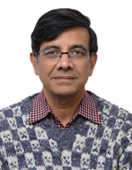
Srinivas V. Veeravalli obtained his PhD from Cornell University in 1989 and after a two-year stint as a post-doctoral fellow at the Center for Turbulence Research, joined the Applied Mechanics Department at IIT Delhi as a faculty member. Since December 1991 he has worked there, barring a short stay (2002-2004) at SDM College of Engineering and Technology, Dharwad.
Prof. Veeravalli divides his research time between conventional engineering and “traditional” science and engineering. In the former, he has worked on fundamental problems such as the applicability of stability theory to fully developed wall-bounded turbulent flows and the interaction of boundary-layer and free-stream turbulence, and applied problems such as optimised ceiling fans, vertical axis wind turbines etc. In the latter, he has studied several examples of traditional engineering structures related to water, such as the Anangpur Dam (near Delhi), the kuin-par system of Rajasthan and the Grand Anicut (Kallanai) of Tamil Nadu
Abstract of the lectures
We will examine some examples of traditional science and engineering, in India, related to water. Our interest in these structures stems primarily from the expectation that they provide illustrations of a different point of view and method of analysis in science, engineering and design. It is of course important that these systems have existed for several centuries, perhaps even millennia, and have survived and continue to function efficiently unless impaired by interventions that do not altogether comprehend the design principles presupposed in these structures. In each case the attempt will be to understand the basis of design and functioning of these systems, which are innovations specific to the region, topography and local needs and at the same time take account of the larger ecosystem and ecological principles. In other words, they are not just based on random rules of thumb (jugaad local interventions) but have a theoretical basis and method. These structures then illustrate successful and functioning experiments in engineering which presuppose an alternative theory of science, engineering and design. They would significantly contribute to laying the foundations of a debate that challenges the presuppositions and method of modern/mainstream science, engineering and design.
In the first lecture we will discuss the Anangpur dam and the kuin-par system of Rajasthan. The second would focus on the Grand Anicut and the tank-anicut system prevalent in South India.